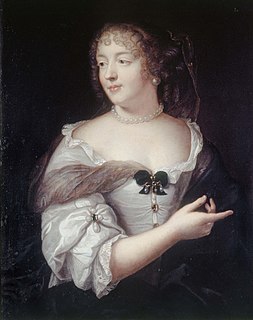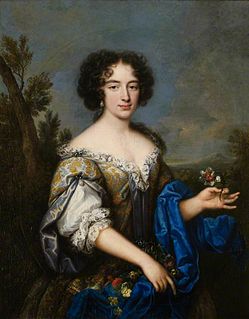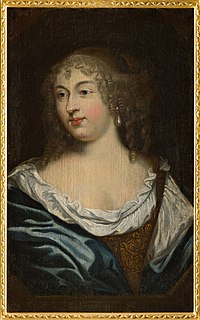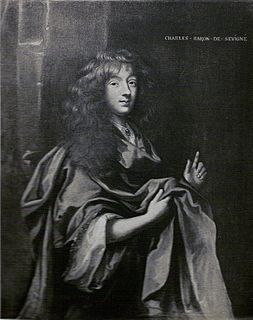
Marie de Miramion, also known as Marie Bonneau, or Marie Bonneau de Rubella Beauharnais de Miramion (1629-1696), was a French religious figure, known for her piety and the organizations she founded. [1]

Marie de Miramion, also known as Marie Bonneau, or Marie Bonneau de Rubella Beauharnais de Miramion (1629-1696), was a French religious figure, known for her piety and the organizations she founded. [1]
Marie de Miramion was the daughter of Jacques Bonneau, seigneur de Rubelles, conseiller et secretaire du roi. [2] Her mother died when Marie was nine years old. Left a widower with five small children, her father deemed it prudent to join the household of his brother, M. de Bonneau, Seigneur of Plessis and Valmar. There she came to love dancing and the theatre. [3]
Marie is described as a beautiful young woman, with an alabaster complexion, chestnut hair, and dark blue eyes. Upon the death of her father, when she was fifteen, her aunt and uncle took on the responsibility of arranging an appropriate marriage. On 27 April 1645 she married twenty-seven-year-old Jean-Jacques de Beauharnais, seigneur de Miramion, conseiller du roi en sa cour du Parlement de Paris, who later fell ill of a fever and died the same year. [2] They had one child, a daughter also named Marie.

Two years later Marie contracted smallpox but recovered. Her young daughter suffered from a serious chest ailment. Fearing the loss of her only child, Marie vowed that if the child recovered, she would make a pilgrimage to the Chapel of St. Valerian. The following August, Marie, accompanied by her mother-in-law and attendants, were waylaid en route by individuals in the employ of a would-be suitor. Her traveling companions were left in the woods and the coach driven post haste to the fortress Chateau de Launay, owned by Count Roger de Bussy-Rabutin, a notorious libertine. But Bussy-Rabutin was forced to free her when Marie refused to take either food or water until released. He had also received word that the Queen Regent of France, upon learning that a lady of the court had been abducted by one of the court nobles, had ordered an armed regiment of soldiers to rescue her. Nor did he have the support of his men, who had been under the impression that the abduction had been a ruse staged for the benefit of the lady's family. [3]
Her daughter was put to board at the convent of the Visitation, on the Rue de St. Antoine, where Marie also lived for part of the year. [2] It was not unusual at that time, for ladies to retire for weeks or even months to religious houses to practice prayer and enjoy a period of pious solitude. Her family saw this as a precaution against any second attempt on the part of Bussy-Rabutin. [3] In 1649, Marie made a vow of chastity following a retreat at the motherhouse of the Filles de la Charite and took up the life of a lay devote. [2] She formed a group of girls to teach school and care for the sick in her parish and later combined them with another group of devotes under the name of the "Filles de Sainte-Genevieve". [2] In addition, she founded an orphanage; a refuge for endangered girls (later absorbed into the Hopital General); and a retreat house. [2] After 1678, she served as a lay superior of the Filles de la Providence. [2] She is remembered as a founder of one of the teaching orders. [4]

Roger de Rabutin, comte de Bussy, commonly known as Bussy-Rabutin, was a French memoirist. He was the cousin and frequent correspondent of Madame de Sévigné.

The King's Daughters is a term used to refer to the approximately 800 young French women who immigrated to New France between 1663 and 1673 as part of a program sponsored by King Louis XIV. The program was designed to boost New France's population both by encouraging male colonizers to settle there, and by promoting marriage, family formation and the birth of children. While women and girls certainly immigrated to New France both before and after this time period, they were not considered to be filles du roi, as the term refers to women and girls who were actively recruited by the government and whose travel to the colony was paid for by the king. They were also occasionally known as the King's Wards.

Catherine de Vivonne, marquise de Rambouillet, known as Madame de Rambouillet, was a society hostess and a major figure in the literary history of 17th-century France.

Françoise-Athénaïs de Rochechouart de Mortemart, Marquise of Montespan, better known as Madame de Montespan, was the most celebrated maîtresse-en-titre of King Louis XIV of France, by whom she had seven children.

Marie de Rabutin-Chantal, marquise de Sévigné, also widely known as Madame de Sévigné or Mme de Sévigné, was a French aristocrat, remembered for her letter-writing. Most of her letters, celebrated for their wit and vividness, were addressed to her daughter, Françoise-Marguerite de Sévigné. She is revered in France as one of the great icons of French 17th-century literature.

Louise de La Vallière was a mistress of Louis XIV of France from 1661 to 1667. She later became the Duchess of La Vallière and Duchess of Vaujours in her own right. She has no known surviving descendants. Louise was also very religious and she led a religious penance for herself near the end of her life.

Genevieve, is the patroness saint of Paris in the Roman Catholic and Eastern Orthodox traditions. Her feast day is kept on 3 January.

Gabrielle Anne Cisterne de Courtiras, vicomtesse de Saint-Mars, nom de plumeCountess Dash, was a prolific French writer.

Françoise-Marguerite de Sévigné, comtesse de Grignan, was a French aristocrat, remembered for the letters that her mother, Madame de Sévigné, wrote to her.

Charles de Sévigné (1648–1713) was a French aristocrat and soldier. He was the son of French literary icon Madame de Sévigné.

François Adhémar de Monteil, comte de Grignan was a French aristocrat, remembered chiefly for being Lieutenant-Governor of Provence and the beloved son-in-law of Madame de Sévigné.

Jean-Antoine de Mesmes, comte d'Avaux (1661–1723) was a premier president of the Parlement of Paris and member of the Académie française. As premier president he presided at the rescinding of the will of Louis XIV and in 1720 at the remonstrance against the regent, Philippe of Orléans, for allowing Law's disastrous financial scheme and appointing Guillaume Dubois as archbishop of Cambrai.

Beauharnais is a French noble family. It is now headed by the Duke of Leuchtenberg, descendant in male line of Eugène de Beauharnais.

François V de Beauharnais was a French nobleman, soldier, politician, colonial governor and admiral. He was seigneur de Beaumont et de Bellechauve, baron de Beauville, 1st marquis de la Ferté-Beauharnais, chef d'escadre des armées royales, and governor of the French colony of Martinique. He was the son of Claude de Beauharnais (1680–1738), sieur de Beaumont et de Bellechauve, and his wife Renée Hardouineau.
Claude de Beauharnais was a French nobleman. He was sieur de Beaumont et de Bellechauve, captain des vaisseaux du roi, and a knight of the Order of Saint Louis. He was the son of François IV de Beauharnais, seigneur de La Boische and his wife Marie Marguerite-Françoise Puyvart de Chastullé.

Pierre d'Amboise was a French nobleman of the House of Amboise. He was a son of Hugh VIII of Amboise, who was killed at the battle of Agincourt, and of Jeanne de Guénand.

Marie de Lorraine was a princess of the House of Lorraine-Guise and Princess of Monaco as consort of Antonio I of Monaco. She was the mother of Louise Hippolyte Grimaldi, the only sovereign Princess of Monaco.

Captain François-Marie Renaud d'Avène des Méloizes was a French Cavalry officer who came to New France in 1685 in command of the Troupes de Marine and led the successful expedition against the Senecas. The Comte de Frontenac considered him "one of the best and wisest officers" in Canada. He is buried in the vaults of Notre-Dame Basilica-Cathedral, Quebec City.
Events from the year 1670 in France
Anne-Armande de Crequy née de Saint Gelais de Lansac (1637-1709) was a French court official. She served as Première dame d'honneur to the queen of France, Maria Theresa of Spain, from 1679 until 1683.